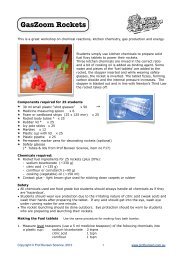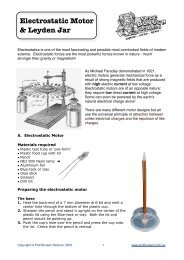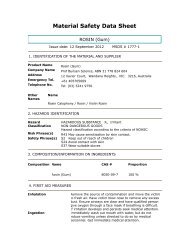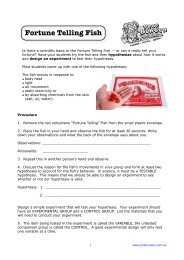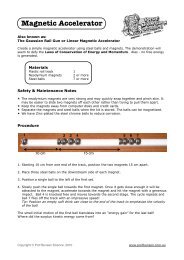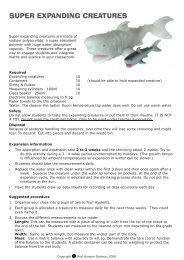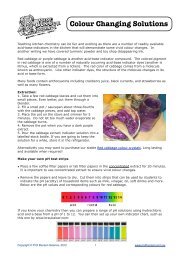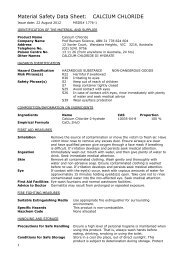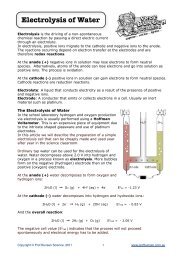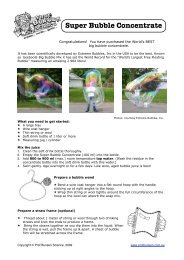Thermoplastic Polymer - Prof Bunsen
Thermoplastic Polymer - Prof Bunsen
Thermoplastic Polymer - Prof Bunsen
You also want an ePaper? Increase the reach of your titles
YUMPU automatically turns print PDFs into web optimized ePapers that Google loves.
<strong>Thermoplastic</strong> <strong>Polymer</strong><br />
Contents:<br />
Poly caprolactone 150 g<br />
<strong>Thermoplastic</strong>s are polymers that can be heated and reformed over and over. Poly<br />
caprolactone is a great example of a thermoplastic as it melts conveniently at 58 to 60 °C.<br />
PROCEDURE<br />
Required<br />
Hot water above 75 °C<br />
Glass beaker<br />
Glass stirring rod<br />
Tongs<br />
Poly caprolactone granules<br />
Procedure<br />
Pour a number of poly caprolactone granules into the hot water in the glass beaker.<br />
Stir the granules with the glass rod while observing the colour change that takes place. The<br />
granules will become pliable and sticky and cling to each other. When all of the polymer has turned<br />
translucent then the polymer has melted.<br />
Lift the softened polymer from the hot water using tongs or the glass rod.<br />
The polymer will remain pliable for 5 – 7 minutes and can be moulded into many different<br />
shapes. If students are not happy with their first attempt, they can put the polymer back in the hot<br />
water to soften.<br />
WARNING: The melted polymer may be hot. Instruct students not to put the polymer into their<br />
mouths. It bonds to metal braces. Students should not make bracelets or rings as the polymer will<br />
harden and be difficult to remove.<br />
WHAT IS HAPPENING?<br />
A chocolate slab can be heated and shaped into an Easter egg. On a hot day the Easter egg, again, is<br />
transformed into a new shape. Some polymers can be melted, cooled and re-melted just as with<br />
chocolate.<br />
<strong>Polymer</strong>s that can be heated and reformed over and over again are known as thermoplastics. This<br />
group makes up the majority of man-made polymers. These polymers can be shaped into any form.<br />
After heating, it can be shaped by extrusion – that is forcing it through a die. The heated polymer can<br />
also be poured or pressed into a mould. This is called moulding.<br />
On the other hand, when heat is applied to a raw egg, it solidifies as it is transformed into a solid<br />
boiled egg. After cooling, it can not be transformed into another shape by heating. A group of<br />
polymers behave similarly. This type of polymer is known as thermoset polymers. Their molecules<br />
form cross linkages when they are heated. This creates a rigid, permanent structure. Just as a boiled<br />
egg can't be un-boiled, thermoset plastics can't be softened again once it is heated and formed. We<br />
use thermosets in applications where durability, heat resistance and strength are determining factors,<br />
for example as pan handles, refrigerator insulation, in the car, electrical and space industries.<br />
Our Mushrooms in Minutes School Demo Pack prepares polyurethane, a thermoset polymer.<br />
Copyright <strong>Prof</strong> <strong>Bunsen</strong> Science, 2006
The main differences in properties between the two types of polymers are:<br />
THERMOPLASTIC POLYMERS<br />
Can be heated and moulded over and<br />
over.<br />
Have long, unconnected molecule chains<br />
with no or few crosslinks<br />
Can ignite and burn when heated<br />
THERMOSET POLYMERS<br />
Once formed it cannot be softened by<br />
heat<br />
Have many crosslinks between the<br />
polymer chains, forming a rigid<br />
structure<br />
Usually resist burning but may char at<br />
high temperatures<br />
Real life applications of Poly Caprolactone<br />
Many applications take advantage of the material remaining workable for a period when cooled<br />
below the melting point. Applications are<br />
shoe soles, heels and toe stiffeners;<br />
hot melt glues;<br />
rigid and lightweight splints & casts replacing Plaster of Paris as orthopaedic support;<br />
orthodontic moulding systems, etc.<br />
Disposal<br />
Can be re-used many times. If there is a need to dispose of the polymer then do so in compliance<br />
with local/federal regulations. Product is not significantly hazardous for the environment.<br />
Safety<br />
Not classified as a hazardous chemical. See MSDS on our website.<br />
References:<br />
Fun with Chemistry Vol. 2, M & J Sarquis, University of Wisconsin-Madison, 1993<br />
www.profbunsen.com.au<br />
Copyright <strong>Prof</strong> <strong>Bunsen</strong> Science, 2006




